Shuohang Wang
Phi-4-Mini Technical Report: Compact yet Powerful Multimodal Language Models via Mixture-of-LoRAs
Mar 03, 2025Abstract:We introduce Phi-4-Mini and Phi-4-Multimodal, compact yet highly capable language and multimodal models. Phi-4-Mini is a 3.8-billion-parameter language model trained on high-quality web and synthetic data, significantly outperforming recent open-source models of similar size and matching the performance of models twice its size on math and coding tasks requiring complex reasoning. This achievement is driven by a carefully curated synthetic data recipe emphasizing high-quality math and coding datasets. Compared to its predecessor, Phi-3.5-Mini, Phi-4-Mini features an expanded vocabulary size of 200K tokens to better support multilingual applications, as well as group query attention for more efficient long-sequence generation. Phi-4-Multimodal is a multimodal model that integrates text, vision, and speech/audio input modalities into a single model. Its novel modality extension approach leverages LoRA adapters and modality-specific routers to allow multiple inference modes combining various modalities without interference. For example, it now ranks first in the OpenASR leaderboard to date, although the LoRA component of the speech/audio modality has just 460 million parameters. Phi-4-Multimodal supports scenarios involving (vision + language), (vision + speech), and (speech/audio) inputs, outperforming larger vision-language and speech-language models on a wide range of tasks. Additionally, we experiment to further train Phi-4-Mini to enhance its reasoning capabilities. Despite its compact 3.8-billion-parameter size, this experimental version achieves reasoning performance on par with or surpassing significantly larger models, including DeepSeek-R1-Distill-Qwen-7B and DeepSeek-R1-Distill-Llama-8B.
Is Your World Simulator a Good Story Presenter? A Consecutive Events-Based Benchmark for Future Long Video Generation
Dec 17, 2024Abstract:The current state-of-the-art video generative models can produce commercial-grade videos with highly realistic details. However, they still struggle to coherently present multiple sequential events in the stories specified by the prompts, which is foreseeable an essential capability for future long video generation scenarios. For example, top T2V generative models still fail to generate a video of the short simple story 'how to put an elephant into a refrigerator.' While existing detail-oriented benchmarks primarily focus on fine-grained metrics like aesthetic quality and spatial-temporal consistency, they fall short of evaluating models' abilities to handle event-level story presentation. To address this gap, we introduce StoryEval, a story-oriented benchmark specifically designed to assess text-to-video (T2V) models' story-completion capabilities. StoryEval features 423 prompts spanning 7 classes, each representing short stories composed of 2-4 consecutive events. We employ advanced vision-language models, such as GPT-4V and LLaVA-OV-Chat-72B, to verify the completion of each event in the generated videos, applying a unanimous voting method to enhance reliability. Our methods ensure high alignment with human evaluations, and the evaluation of 11 models reveals its challenge, with none exceeding an average story-completion rate of 50%. StoryEval provides a new benchmark for advancing T2V models and highlights the challenges and opportunities in developing next-generation solutions for coherent story-driven video generation.
Mojito: Motion Trajectory and Intensity Control for Video Generation
Dec 12, 2024



Abstract:Recent advancements in diffusion models have shown great promise in producing high-quality video content. However, efficiently training diffusion models capable of integrating directional guidance and controllable motion intensity remains a challenging and under-explored area. This paper introduces Mojito, a diffusion model that incorporates both \textbf{Mo}tion tra\textbf{j}ectory and \textbf{i}ntensi\textbf{t}y contr\textbf{o}l for text to video generation. Specifically, Mojito features a Directional Motion Control module that leverages cross-attention to efficiently direct the generated object's motion without additional training, alongside a Motion Intensity Modulator that uses optical flow maps generated from videos to guide varying levels of motion intensity. Extensive experiments demonstrate Mojito's effectiveness in achieving precise trajectory and intensity control with high computational efficiency, generating motion patterns that closely match specified directions and intensities, providing realistic dynamics that align well with natural motion in real-world scenarios.
Temperature-Centric Investigation of Speculative Decoding with Knowledge Distillation
Oct 14, 2024Abstract:Speculative decoding stands as a pivotal technique to expedite inference in autoregressive (large) language models. This method employs a smaller draft model to speculate a block of tokens, which the target model then evaluates for acceptance. Despite a wealth of studies aimed at increasing the efficiency of speculative decoding, the influence of generation configurations on the decoding process remains poorly understood, especially concerning decoding temperatures. This paper delves into the effects of decoding temperatures on speculative decoding's efficacy. Beginning with knowledge distillation (KD), we first highlight the challenge of decoding at higher temperatures, and demonstrate KD in a consistent temperature setting could be a remedy. We also investigate the effects of out-of-domain testing sets with out-of-range temperatures. Building upon these findings, we take an initial step to further the speedup for speculative decoding, particularly in a high-temperature generation setting. Our work offers new insights into how generation configurations drastically affect the performance of speculative decoding, and underscores the need for developing methods that focus on diverse decoding configurations. Code is publically available at https://github.com/ozyyshr/TempSpec.
LoRC: Low-Rank Compression for LLMs KV Cache with a Progressive Compression Strategy
Oct 04, 2024



Abstract:The Key-Value (KV) cache is a crucial component in serving transformer-based autoregressive large language models (LLMs), enabling faster inference by storing previously computed KV vectors. However, its memory consumption scales linearly with sequence length and batch size, posing a significant bottleneck in LLM deployment. Existing approaches to mitigate this issue include: (1) efficient attention variants integrated in upcycling stages, which requires extensive parameter tuning thus unsuitable for pre-trained LLMs; (2) KV cache compression at test time, primarily through token eviction policies, which often overlook inter-layer dependencies and can be task-specific. This paper introduces an orthogonal approach to KV cache compression. We propose a low-rank approximation of KV weight matrices, allowing for plug-in integration with existing transformer-based LLMs without model retraining. To effectively compress KV cache at the weight level, we adjust for layerwise sensitivity and introduce a progressive compression strategy, which is supported by our theoretical analysis on how compression errors accumulate in deep networks. Our method is designed to function without model tuning in upcycling stages or task-specific profiling in test stages. Extensive experiments with LLaMA models ranging from 8B to 70B parameters across various tasks show that our approach significantly reduces the GPU memory footprint while maintaining performance.
GRIN: GRadient-INformed MoE
Sep 18, 2024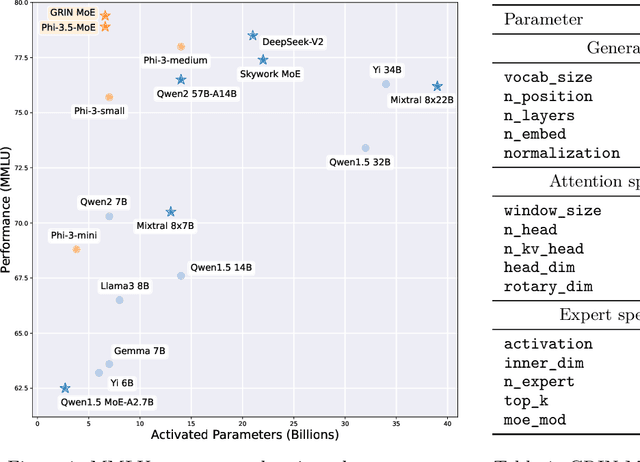
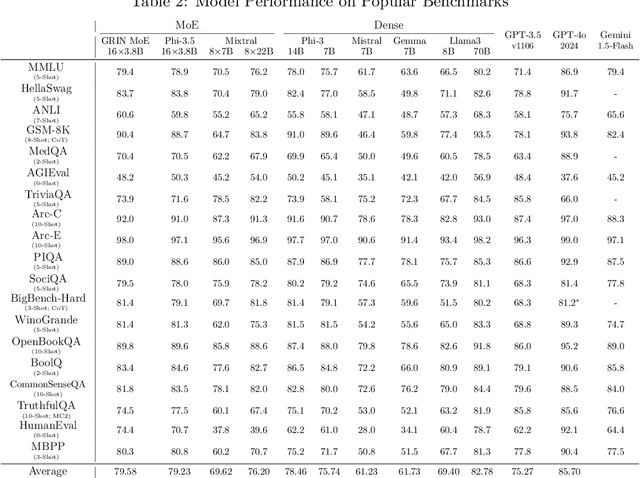
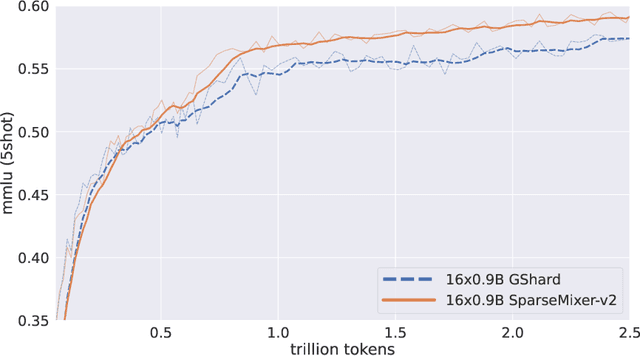

Abstract:Mixture-of-Experts (MoE) models scale more effectively than dense models due to sparse computation through expert routing, selectively activating only a small subset of expert modules. However, sparse computation challenges traditional training practices, as discrete expert routing hinders standard backpropagation and thus gradient-based optimization, which are the cornerstone of deep learning. To better pursue the scaling power of MoE, we introduce GRIN (GRadient-INformed MoE training), which incorporates sparse gradient estimation for expert routing and configures model parallelism to avoid token dropping. Applying GRIN to autoregressive language modeling, we develop a top-2 16$\times$3.8B MoE model. Our model, with only 6.6B activated parameters, outperforms a 7B dense model and matches the performance of a 14B dense model trained on the same data. Extensive evaluations across diverse tasks demonstrate the potential of GRIN to significantly enhance MoE efficacy, achieving 79.4 on MMLU, 83.7 on HellaSwag, 74.4 on HumanEval, and 58.9 on MATH.
Cost-Effective Proxy Reward Model Construction with On-Policy and Active Learning
Jul 02, 2024Abstract:Reinforcement learning with human feedback (RLHF), as a widely adopted approach in current large language model pipelines, is \textit{bottlenecked by the size of human preference data}. While traditional methods rely on offline preference dataset constructions, recent approaches have shifted towards online settings, where a learner uses a small amount of labeled seed data and a large pool of unlabeled prompts to iteratively construct new preference data through self-generated responses and high-quality reward/preference feedback. However, most current online algorithms still focus on preference labeling during policy model updating with given feedback oracles, which incurs significant expert query costs. \textit{We are the first to explore cost-effective proxy reward oracles construction strategies for further labeling preferences or rewards with extremely limited labeled data and expert query budgets}. Our approach introduces two key innovations: (1) on-policy query to avoid OOD and imbalance issues in seed data, and (2) active learning to select the most informative data for preference queries. Using these methods, we train a evaluation model with minimal expert-labeled data, which then effectively labels nine times more preference pairs for further RLHF training. For instance, our model using Direct Preference Optimization (DPO) gains around over 1% average improvement on AlpacaEval2, MMLU-5shot and MMLU-0shot, with only 1.7K query cost. Our methodology is orthogonal to other direct expert query-based strategies and therefore might be integrated with them to further reduce query costs.
Self-Exploring Language Models: Active Preference Elicitation for Online Alignment
May 29, 2024



Abstract:Preference optimization, particularly through Reinforcement Learning from Human Feedback (RLHF), has achieved significant success in aligning Large Language Models (LLMs) to adhere to human intentions. Unlike offline alignment with a fixed dataset, online feedback collection from humans or AI on model generations typically leads to more capable reward models and better-aligned LLMs through an iterative process. However, achieving a globally accurate reward model requires systematic exploration to generate diverse responses that span the vast space of natural language. Random sampling from standard reward-maximizing LLMs alone is insufficient to fulfill this requirement. To address this issue, we propose a bilevel objective optimistically biased towards potentially high-reward responses to actively explore out-of-distribution regions. By solving the inner-level problem with the reparameterized reward function, the resulting algorithm, named Self-Exploring Language Models (SELM), eliminates the need for a separate RM and iteratively updates the LLM with a straightforward objective. Compared to Direct Preference Optimization (DPO), the SELM objective reduces indiscriminate favor of unseen extrapolations and enhances exploration efficiency. Our experimental results demonstrate that when finetuned on Zephyr-7B-SFT and Llama-3-8B-Instruct models, SELM significantly boosts the performance on instruction-following benchmarks such as MT-Bench and AlpacaEval 2.0, as well as various standard academic benchmarks in different settings. Our code and models are available at https://github.com/shenao-zhang/SELM.
Multi-LoRA Composition for Image Generation
Feb 26, 2024
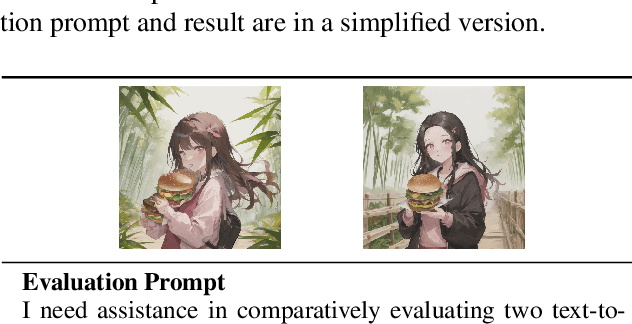
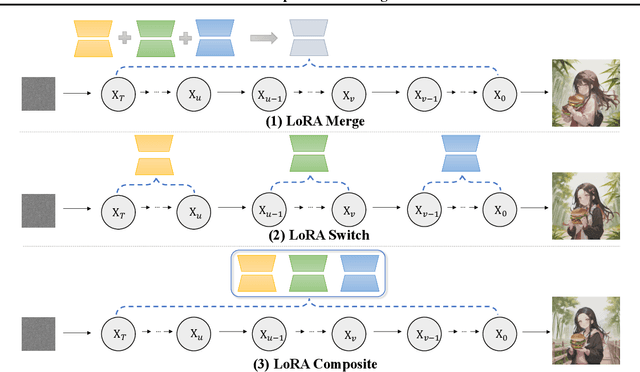
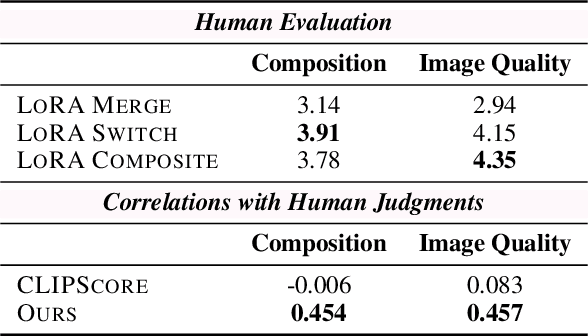
Abstract:Low-Rank Adaptation (LoRA) is extensively utilized in text-to-image models for the accurate rendition of specific elements like distinct characters or unique styles in generated images. Nonetheless, existing methods face challenges in effectively composing multiple LoRAs, especially as the number of LoRAs to be integrated grows, thus hindering the creation of complex imagery. In this paper, we study multi-LoRA composition through a decoding-centric perspective. We present two training-free methods: LoRA Switch, which alternates between different LoRAs at each denoising step, and LoRA Composite, which simultaneously incorporates all LoRAs to guide more cohesive image synthesis. To evaluate the proposed approaches, we establish ComposLoRA, a new comprehensive testbed as part of this research. It features a diverse range of LoRA categories with 480 composition sets. Utilizing an evaluation framework based on GPT-4V, our findings demonstrate a clear improvement in performance with our methods over the prevalent baseline, particularly evident when increasing the number of LoRAs in a composition.
SciAgent: Tool-augmented Language Models for Scientific Reasoning
Feb 21, 2024



Abstract:Scientific reasoning poses an excessive challenge for even the most advanced Large Language Models (LLMs). To make this task more practical and solvable for LLMs, we introduce a new task setting named tool-augmented scientific reasoning. This setting supplements LLMs with scalable toolsets, and shifts the focus from pursuing an omniscient problem solver to a proficient tool-user. To facilitate the research of such setting, we construct a tool-augmented training corpus named MathFunc which encompasses over 30,000 samples and roughly 6,000 tools. Building on MathFunc, we develop SciAgent to retrieve, understand and, if necessary, use tools for scientific problem solving. Additionally, we craft a benchmark, SciToolBench, spanning five scientific domains to evaluate LLMs' abilities with tool assistance. Extensive experiments on SciToolBench confirm the effectiveness of SciAgent. Notably, SciAgent-Mistral-7B surpasses other LLMs with the same size by more than 13% in absolute accuracy. Furthermore, SciAgent-DeepMath-7B shows much superior performance than ChatGPT.
 Add to Chrome
Add to Chrome Add to Firefox
Add to Firefox Add to Edge
Add to Edge